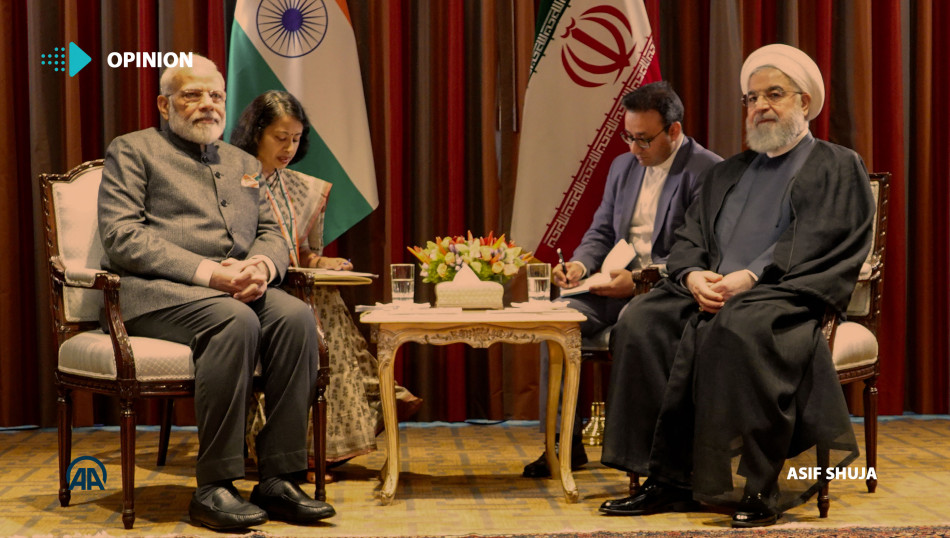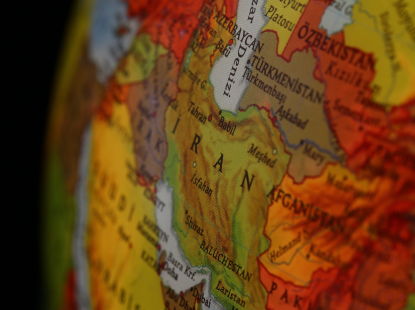India-Iran Relations: A Comprehensive Review
Iran, one of the richest countries in hydrocarbon and India, a rapidly growing economy with a deep thirst for energy are the hallmarks of the India-Iran relationship. Nevertheless, Iran’s strategic significance to India is crucial, compelling India to remain tied to Iran in face of insurmountable difficulties. Under the current scenario, had relations been solely based on energy, Iran would have drifted away from India. However, Iran’s geographical position is paramount to India’s geopolitical outreach, especially to Central Asia, a rich reservoir of natural resources. Similarly, Iran is vital for India’s access to Afghanistan in which India has immense strategic and security interests.
The benefits of India-Iran ties are mutual. An important element in the India-Iran relationship is India’s status as a huge market for Iranian products. India’s choice of Iran as a gateway to Central Asia and Afghanistan also has positive repercussions on Iran’s aspirations of becoming a regional hub for trade and transit. Finally, under the backdrop of Iran’s nuclear controversy and US efforts to isolate Iran, the continued relationship of the Islamic Republic of Iran with the world’s largest democracy has immense ideational value.
Such an understanding of reciprocally advantageous consequences motivated India and Iran to formally sign two consecutive comprehensive joint documents reflecting their vision of strategic partnership. The first is the ‘Tehran Declaration’ signed in April 2001, and the second is the ‘New Delhi Declaration’ signed in January 2003. While these documents serve as a template for greater regional and global cooperation, they also highlight the realisation of the scope of such a partnership. Notwithstanding these efforts, the cloud of the Iranian nuclear controversy and India’s need for closeness to the United States had implications on India-Iran relations. Before the two countries could fully implement the tenets of the New Delhi Declaration, the Iranian nuclear controversy intensified, leading to a vote on a resolution at the International Atomic Energy Agency (IAEA) in September 2005, to refer the Iranian nuclear file to the United Nations Security Council. By virtue of India’s membership on the IAEA board at that time, India was compelled to take a stand. The fact that India voted against Iran at a time when it was also negotiating a civil nuclear deal with the United States, created mistrust in the minds of the Iranians.
The maturity and compulsions of India-Iran relations along with the countries’ leaders’ pragmatism effectively manoeuvred this relationship, leaving this teasing episode behind sooner than expected. Still, the issues surrounding the Iranian nuclear programme, its regional role, and resultant antagonism with other countries have its share of pressure on the potentially deep and broad bilateral ties between India and Iran. Since the onset of this controversy, India has indulged in a balancing act between its relationship with Iran, on one hand, and with the US, Saudi Arabia, and Israel, on the other. The current US effort to impose “maximum pressure” on Iran to ensure its seclusion has its toll on the India-Iran relationship. Amongst the visible effects of the Iran-US enmity is Iran’s increased ties with China, an adversary of India. If concluded, the reported 25-years of strategic partnership between Iran and China is likely to have further implications on the dynamics of the India-Iran relationship.
The Current Scenario
In order to understand the current depth and anticipate the future course of India-Iran relations, three core issues could be underlined, which serve as a pointer to this trajectory. The first is Iran’s Farzad-B Gas Field in which an Indian state-owned company, ONGC, was involved at the discovery stage. After the detection of gas, a protracted negotiation between the two sides failed to result in India obtaining the rights to its development, translating into Iran deciding to independently develop this field. India has officially maintained that their cooperation in this realm was “impacted by policy changes on the Iranian side.” According to India’s Ministry of External Affairs, in January 2020, India was informed that “in the immediate future, Iran would develop the field on its own and would like to involve India appropriately at a later stage.” India has also maintained that “this matter remains under discussion.”
The second prominent issue that has become a marker of the evolving India-Iran relationship is the proposed railway line connecting Chabahar to Zahedan, the capital of Iran’s Sistan and Baluchestan Province. This project was conceived to link the Chabahar Port to Afghanistan, which is of sizeable strategic interest to India. Recently, the media reported that Iran had withdrawn its proposal from India. However, India has denied this, officially maintaining that the two countries are currently in talks to fructify this venture. According to India’s Ministry of External Affairs, a designated Indian company, IRCON, is in talks with an Iranian company, CDTIC, under Iran’s Ministry of Roads and Transportation and has, so far, completed the site inspection and review of the feasibility report. Moreover, both sides are currently engaging in detailed discussions on other aspects of the project, especially Iran’s financial challenges. It was also mentioned that in December 2019, the two sides reviewed the details of this project in their 19th India-Iran Joint Commission Meeting in Tehran.
The third important issue is the Chabahar Port project. In this realm, India has achieved considerable success, specifically in terms of starting the operation of this project after the initial investment for its development. India’s initial commitment was in 2003, and the port was finally operationalized in 2016. Despite the impediments created by US sanctions, the two countries made significant progress on this front and since 2018, an Indian company has been operating the port. According to India’s Ministry of External Affairs, as of July 2020, the port had handled 82 vessels, including 52 in the previous 12 months, effectively handling a total of 8,200 containers amounting to 12 lakh tons of bulk cargo. The two countries are further exploring ways to boost traffic towards making the port more economically viable and increasing its usage for Afghanistan as well as Central Asia.
Notably, in the Indian strategic discourses, Chabahar has often been portrayed as a strategic gain for India, especially given China’s participation in the development of Pakistan’s Gwadar Port. However, Iran has avoided linking any strategy dimension to the Chabahar Port and has articulated its willingness to open the door of its further development to other countries, including China. The future developments in the arena of the Chabahar Port and the depth of India’s participation, as well as China’s presence or absence, will have ramifications on the evolving strategic partnership between India and Iran.
The Way Ahead
A comprehensive review of the depth, nature, and trajectory of India-Iran relations is also indicative of the nature of India’s broader approach to the Middle East. The recent developments where a war-weary United States is increasingly perceived as returning to its traditional role of an offshore balancer in the Middle East has created avenues for other powers such as Russia, China, Turkey, and India to make inroads in the region. The recent stopovers in Tehran by two senior Indian Cabinet ministers, the Defence Minister and Foreign Minister, are illustrative of India’s desire to remain in the game.
Despite the end of the Cold War and India’s economic compulsions yielding an enhanced India-US partnership, the old era of India-Russia military partnership remains intact, and Russia still stands as India’s top military supplier. More importantly, India has joined the club of Russian S400 missile defence system, which China, Turkey, and Iran also belong, reflecting a unique commonality between these five countries. The fact that the transfer of Russia’s S400 missile defence system is antithetical to US strategic interest, India’s enlistment in this club may provide some hint to India’s eventual leaning in the balance of power between the two camps respectively led by the US and Russia in the Middle East, a region where Iran is a key actor. This, however, is a long-term scenario.
In the foreseeable future, India’s strategic and economic standing is likely to provide it a limited role in the Middle East; directly impacting its ties with Iran. As India’s strength grows and it is more capable of projecting power away from its borders, its foreign policy might witness according changes. Still, India’s offshore manoeuvrability might be constricted by its position as a state sandwiched by two antagonistic nuclear powers, viz., China and Pakistan, claiming a large chunk of its strategic resources. Another limitation is that unlike China, India does not enjoy permanent membership in the United Nations Security Council; an apparent factor in Iran’s calculations while choosing between India and China.
Despite India’s energy dependence on the Middle East, its economic structure ties it more to the West. A prodigious portion of India’s GDP constitutes the service sector whose destination is primarily the West, including the US; a component in India’s risk assessments in forging ties with Iran. This often causes a mismatch between India’s aspirations and deliveries, creating a scenario in which its policy towards Iran either looks as ambivalent or succumbing to US pressure. The truth is that India’s relationship with Iran is as much predicated on its national interests as its relations with any other country.
Unlike India, China has a rapidly developing manufacturing industry for which it needs raw material as well as expanding markets and this is a potent aspect in its analysis of determining the risks of US sanctions while forming ties with Iran. Consequently, the two countries are establishing a long-term relationship that is likely to prove as a game-changer in the Middle East and have further negative repercussions on India-Iran relations.
The Abraham Accords, which further consolidates the front against Iran and is potentially isolating it more, is still another development that may further impede the growth of India-Iran relations. Furthermore, even if Donald Trump is defeated in the US presidential elections, US efforts of isolating Iran is more likely to continue as there is a bipartisan consensus in the US to check Iran’s regional influence and curtail its missile and nuclear programme, issues on which Iran is not ready to compromise. The war against the Islamic State of Iraq and Syria (ISIS), a factor in Barack Obama determining to agree to the Iran nuclear deal, is no longer present to serve as an incentive for the US to enter into a similar agreement.
For India, Iran proved to be a territory to extend its influence offshore, both economic and strategic. However, Iran has traditionally tied itself to the West and is recently drawing nearer to China in a fashion that may put its relations with India on uncomfortable ground. Such realisation by India, especially through the painful ways of delayed or failed negotiations, appears to be instilling a sentiment of fatigue in the Indian attempt of nurturing closer ties with Iran. These are some indicators that may compel us to believe that the pace of India-Iran relations may further slow down until a long-term solution to the Iran-US standoff is found.
Disclaimer: The viewpoints expressed by the authors do not necessarily reflect the opinions, viewpoints and editorial policies of IRAM.











